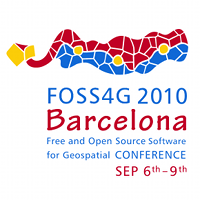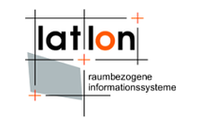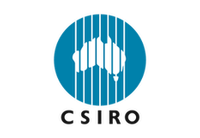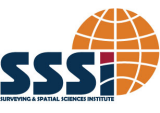|
Loading
|

Session files and videos from the conference program are now starting to be made available online. For presentations currently online please see the following pages:
Keynotes
Presentations
Academic Track
Tutorials
Workshops
Lightening Talks
Posters
Birds of a feather
Spatial Ignite
If you notice your presentation files are missing please don't hesitate to It may be an oversight or we may need you to send us your material again.
FOSS4G Academic Track
Submissions for the academic track have now closed the papers selected for oral presentation on the academic track are listed below. These will be included in a reputed publication, able to disseminate our contribution to FOSS4G research area.
Academic Papers
Collaborative Web-Based Mapping of Real-Time Flight Simulator and Sensor Data
Google Maps is an example of howWeb 2.0 technology such as AJAX can be used to create online map services that are easy to access, user-friendly and fast. Thanks to flexible web-based mapping APIs, it is now possible for non-experts to plot and distribute GIS (Geographic Information System) data to a large audience. Most data plotted so far, however, has been relatively static. In addition, the typical webpage layout has limited the interaction possibilities for online maps when compared with windowed applications. This paper will present a JEE-based publish/ subscribe architecture that allows real-time sensor data to be displayed collaboratively on the web, requiring users to have nothing more than a web browser and Internet connectivity to gain access to that data. The architecture is tested using live data from Microsoft Flight Simulator and data conforming to the OGC Sensor Observation Service (SOS) standard. By using the latest web-based technology from open source projects like OpenLayers and 52North, this paper shows how maps and GIS data can be made more accessible, more social and generally more useful.
Authors: Rabih Dagher, Cristian Gadea, Bogdan Ionescu, Dan Ionescu and Robin Tropper
Biography:
Rabih Dagher is currently doing his Master’s in Computer Science at the University of Ottawa, where he also received his BASc. in Software Engineering in 2006. He’s a certified Java Programmer, and is specialized in the back-end development of JEE Web-based systems.Cristian Gadea is a Computer Science Master’s student at the School of Information Technology and Engineering at the University of Ottawa, Canada, where he also obtained his undergraduate degree in Software Engineering (2007). His research interests include Web 2.0, GIS, mobile computing, human-computer interaction and video game technologies.Dr. Dan Ionescu received Dipl. Ing. and Dr. Ing. degrees from the Polytechnic Institute of Bucharest, Romania, and a Diploma in Mathematics from the University of Timisoara, Romania. He has been with the University of Ottawa since 1985, where he is currently Professor in Computer Engineering and the Director of the Network Computing and Control Technologies (NCCT) Laboratory. His current research interests are distributed systems and applications for the automation of the information technology infrastructure, with applications to autonomic computing.Bogdan Ionescu received his undergraduate degree in Computer Engineering from the School of Information Technology and Engineering at the University of Ottawa and is currently doing his Master’s there. His research interests include networking, data mining, and distributed computing.Robin Tropper graduated with a B.A.Sc. in Software Engineering in 2006, a B.Ed. in Education in 1996 from University of Ottawa and a B.Mus. in Classical Music in 1994 from McGill University. He is now pursuing an M.A.Sc. in Computer Engineering while working at the NCCT Laboratory. Robin’s work focuses on a component-based architecture for a scalable and extensible Real-Time collaborative applications platform. He further aims to facilitate and promote musical performance (as opposed to consumption) with the help of modern technologies.
MapWindow Modeler - A Modular Spatial Modeling Environment for GIS
Development of an open source modeling environment for use with spatial data in a Geographic Information System (GIS) is presented. To date, legacy versions of MapWindow have lacked an integrated modeling environment suitable for linking together independent geospatial and temporal processes at a granular level. This new modeling environment allows users to easily create models which can take advantage of spatial data objects and analytical tools. The design approach focuses on an ITool interface that serves as an independent point for the run-time discovery of geoprocessing extensions. The user interface is automatically generated by the modeler when their tool is instantiated based on parameter characteristics on the ITool interface. The design is also versatile, allowing processes to also be run through a more traditional method of adding a reference and calling the processes as functions programatically.
Authors: Brian Marchionni, Daniel P. Ames, Harold Dunsford
Biography:
Brian Marchionni is a Master’s student at Idaho State University where he is studying Geographic Information Science. Presently he is the lead developer of the MapWindow GIS Modeler, the MapWindow Print Engine and is one of the maintainers of the MapWindow GIS desktop application. He has a Bachelor’s of Computer Science from Concordia University in Montreal with a minor in Geography and has work experience as a professional cartographer.Daniel P. Ames, Ph.D. is the director of the Geospatial Software Lab at the Department of Energy Center for Advanced Energy Studies in Idaho Falls, Idaho where he leads the open source MapWindow GIS software project. He is also an Associate Professor in Geosciences and Civil Engineering at Idaho State University and is the director of ISU’s graduate programs in GIS. Harold (Ted) Dunsford is a Ph.D. student in Engineering and Applied Science at Idaho State University. He is currently the lead developer of the MapWindow 6.0 open source GIS project, a C# .Net project that can run on other platforms using mono. He has a Masters of Physics from Mississippi State University. He also has several years of experience working in industry, including an environmental engineering firm where he worked with geographic information systems, developed custom software, and managed large scale remediation projects in the field.
Media Mapping: Using Georeferenced Images and Audio to provide supporting information for the Analysis of Environmental Sensor Datasets
Field based environmental monitoring projects often fail to gather supporting temporal information on the surroundings, yet these external factors may play a significant part in understanding variations in the collected datasets. For example when sampling air quality the values may change as a result of a bus passing the sampling point, yet this temporal local information is difficult to capture at a consistently high resolution over extended time periods. Here we develop an application which runs on a mobile phone able to capture visual and audio data with corresponding time and location details. We also develop a desktop analysis tool which synchronises the display of this dataset with those captured from environmental sensors. The result is a tool able to assist researchers in understanding local changes in environmental datasets as a result of changes in the nearby surrounding environment.
Authors: Phil Bartie, Simon Kingham
Biography:
Phil Bartie is a PhD candidate at the Geospatial Research Centre, University of Canterbury, NZ. Previously he has worked in government and commercial sectors designing and implementing GIS solutions. He holds a BSc(Hons) in Human and Physical Geography, and MSc in GIS. His research interests include location based services, interface design, and visibility analysis.Dr Simon Kingham is an Associate Professor in the Department of Geography at the University of Canterbury. He came to the to the University of Canterbury in 2000 having completed his PhD at Lancaster University and having worked at the Universities of Newcastle, Huddersfield and Hertfordshire in the UK. In New Zealand Simon has been involved in a variety of pollution related project. He was an author and key contributor to the Fisher et al, 2002, Health effects due to motor vehicle air pollution in New Zealand. Report to the Ministry of Transport. Following this he worked on the Urban air quality processes 2002-04 (funded by the Foundation for Research Science and Technology, NZ), the Health and air pollution in New Zealand (HAPINZ) 2002-2005 (funded by Ministries of/for Health, Transport and Environment), and the Protecting New Zealand’s clean air 2004-08 (funded by the Foundation for Research Science and Technology, NZ).
MapWindow 6.0: An Extensible Architecture for Cartographic Symbology
A robust, extensible architecture is critical to open source projects that have a distributed developer and user base. The MapWindow 6.0 project is using a new architectural paradigm where extensibility is handled from several different plug-in points, rather than a single, application wide design. This allows new kinds of extensibility to be explored such as tools and data providers in addition to the more conventional application wide extensibility. This presentation outlines some of the improvements in the built in cartography, but primarily addresses the .Net architectural decisions that permit run-time discovery of new kinds of custom symbology. Improvements include layering of different kinds of symbols to make a compound symbol as well as establishing cartographic sub-categories based on vector attributes or raster values. The open ended framework allows for an extremely flexible system of run-time discovery so that the core libraries do not have to be recompiled each time an external cartographic improvement is developed.
Authors: Harold A. Dunsford Jr., Daniel P. Ames
Biography:
Daniel P. Ames, Ph.D. is the director of the Geospatial Software Lab at the Department of Energy Center for Advanced Energy Studies in Idaho Falls, Idaho where he leads the open source MapWindow GIS software project. He is also an Associate Professor in Geosciences and Civil Engineering at Idaho State University and is the director of ISU’s graduate programs in GIS. Harold (Ted) Dunsford is a Ph.D. student in Engineering and Applied Science at Idaho State University. He is currently the lead developer of the MapWindow 6.0 open source GIS project, a C# .Net project that can run on other platforms using mono. He has a Masters of Physics from Mississippi State University. He also has several years of experience working in industry, including an environmental engineering firm where he worked with geographic information systems, developed custom software, and managed large scale remediation projects in the field.
A Data System for Visualizing 4-D Atmospheric CO2 Models and Data
This paper describes a geospatial data system that produces KML representations of complex spatio-temporal datasets related to modeling the atmospheric carbon cycle. KML is an open standard language for transferring annotated geospatial data that can be used by many modern geospatial software packages, particularly virtual globe applications. The server component of the data system is built using a variety of open source software packages, which provide flexibility for creating custom geospatial representations of the datasets. The paper shows examples of how Google Earth, a popular virtual globe with a user-friendly interface, can be used by a diverse group of users as a visualization client to explore the complex scientific datasets that are central to the discussion of climate change and global warming.
Authors: Tyler A. Erickson 1, Anna M. Michalak 2, John C. Lin 3
Biography:
Dr. Tyler Erickson is a Research Scientist at the Michigan Tech Research Institute, and holds an Adjunct Assistant Professor appointment in the Department of Civil and Engineering at Michigan Technological University, USA. Dr. Erickson holds a B.S. from Colorado State University, a M.S. for the California Institute of Technology, an Engineer Degree from Stanford University, and a Ph.D. from the University of Colorado. His research interests include algorithm development for geostatistical analysis and designing internet-based geospatial information systems using open source technologies, primarily for managing datasets and models for environmental monitoring. In 2009, he was selected as one of the professional winners in Google’s KML in Research Competition.Dr. Anna M. Michalak is an Associate Professor in the Department of Civil and Environmental Engineering, and holds a joint appointment in the Department of Atmospheric Oceanic and Space Sciences at the University of Michigan, USA. The common theme of her research is the development and application of statistical and geostatistical data fusion methods for optimizing the use of limited in situ and remote sensing environmental data. Dr. Michalak holds a B.Sc. from the University of Guelph, Canada, and M.S. and Ph.D. degrees from Stanford University, California, USA. She is the recipient of the Presidential Early Career Award for Scientists and Engineers, the National Science Foundation CAREER Award, and the Association of Environmental Engineering and Science Professors Outstanding Educator Award. Dr. John C. Lin is an Assistant Professor in the Department of Earth and Environmental Sciences at the University of Waterloo in Canada. He grew up in Taiwan and Japan and went on to receive his A.B., A.M., and Ph.D. from Harvard University. His research interests include 1) atmospheric modelling using Lagrangian methods; 2) carbon cycle science; and 3) exchanges of pollutants, energy, and momentum at the land-atmosphere interface. He has received an Ontario Early Researcher Award, a NOAA Postdoctoral Fellowship in Climate and Global Change, and a Harvard University Distinction in Teaching Award.
Use of Cloud computing in impact assessment of climate change
Climate change could have a pronounced impact on natural and agricultural ecosystems. To assess the impact of climate change, projected climate data have been used as inputs to models. Because such studies are conducted occasionally, it would be useful to employ Cloud computing, which provides multiple instances of operating systems in a virtual environment to do processing on demand without building or maintaining physical computing resources. Furthermore, it would be advantageous to use open source geospatial applications in order to avoid the limitations of proprietary software when Cloud computing is used. In our pilot study, Amazon Web Service – Elastic Compute Cloud (EC2) was used to calculate the number of days with rain in a given month. Daily sets of climate projection data, which were about 70 gigabytes in total, were processed using virtual machines with a customized database transaction application. The application was linked against open source libraries for the climate data and database access. In our study, it took about 32 hours to process 17 billion rows of record in order to calculate the rain day on a global scale over the next 100 years using ten clients and one server instances. Our study showed that Cloud computing could provide the high level of performace for impact assessment studies of climate change that require considerable amount of data.
Authors: Kwang Soo Kim, Doug MacKenzie
Biography:
Kwang Soo Kim, Ph.D. is a scientist at Plant and Food research where he is working on climate risk assessment models. Doug MacKenzie, NDBC. Currently working for Plant & Food Research as an IT Network and Services Analyst. Prevously at Auckland University of Technology – School of Computing and Mathematical Sciences as a lecturer in Networking, Internet Technologies and Network Security.
Development of Track Log & POI Management System using Free and Open Source Software
Recent advanced performance of low-cost GPS and GPS-enabled cell phone has contributed a great deal to the development of location-aware services and systems. The broadband environment has promoted collaborative projects such as OpenStreetMap or other User Generated Contents services. In this research, a web-based prototype system for GPS track log and POI management was developed to archive a collaborative framework in field survey. The main functionalities of the system can be separated by 3 parts; data collection, data management and data quality enhancement. The system supports real-time data collection for the future ubiquitous environment and also can monitor real-time GPS position. This research shows functionalities which can minimize GPS errors using DOP filtering and data quality enhancing techniques using Douglas-Peucker algorithm and PgRouting. The research introduces a system that provides an interoperable framework to work with other geospatial services through open geospatial standards.
Authors: 1 Daisuke Yoshida, 1,2 Xianfeng Song, 1 Venkatesh Raghavan
Biography:
Daisuke Yoshida is a doctoral student at the Graduate School of Creative Cities, Osaka City University and works at the Faculty of Liberal Arts, Tezukayama Gakuin University as a lecturer. He has participated on a Japanese volunteer program, JICA in the Philippines to provide technical assistance for implementing SDI prototype using FOSS4G tools. His research interests are Web-GIS development, LBS, Real-time GPS, Mobile GIS and digital archives. He has also been a FOSS4G trainer at several international workshops. He is a board member OSGeo-Japan Chapter and an organizer for FOSS4G-Osaka annual events.Xianfeng Song research interest is Geo-Processing Workflow and their applications in infrastructure management and environment modeling. His current research include (1) Optimizing geospatial Web services chain based on QoS (2) SWAT model for hydrology simulation and sediment yield estimation (3)Map-Matching and LBS Services. He is presently Associate Professor at the Graduate University of Chinese Academy of Sciences. He is an active member of the OSGeo-China Chapter.Venkatesh Raghavan (Venka) has been involved in OSGeo since its inception. He was one of the Directors in the first OSGeo Board and is currently a Charter Member. He is deeply involved in OSGeo Local Chapters in Asia. Presently based in Japan as Professor of Geoinformatics at Osaka City University. His research interest include distributed geoprocessing, Sensor Net and Remote Sensing for change detection.
Geoprocessing in the Clouds
Cloud Computing is one of the latest hypes in the mainstream IT world. Spatial Data Infrastructures (SDI) with its classical publish-find-bind paradigm have not been affected yet by this emerging trend. This paper reviews this novel technology and tries to identify the paradigm behind it. In particular, the scalability aspect for a cloud enabled 52°North Open Source Web Processing Service is challenged and proven in the exemplary Google Cloud. On this basis, future direction for SDIs and Cloud Computing paradigm are identified.
Authors: Bastian Baranski, Bastian Schäffer, Richard Redweik
Biography:
Bastian Baranski is a research associate at Institute for Geoinformatics (IfGI). His major research focuses on the merger of Spatial Data Infrastructures (SDI) and Grid and Cloud Computing with a special focus in SLAs.Bastian Schäffer is the head of the geoprocessing community at the open source initiative 52°North. He is also a research associate at Institute for Geoinformatics (IfGI). His reseach interests focus on interoperability, SDIs, Geoprocessing Workflows and Cloud Computing.Richard Redweik is a student assistant at the Institute for Geoinformatics (ifgi). He is also working for the open-source initiative 52°North. Currently he is elaborating the use of cloud-computing in geoinformatics.
User-friendly interactive WPS programming
A number of mission critical activities, such as environmental manage ment and risk assessment, heavily depend upon the availability of effective software solutions capable of simulating complex phenomena occurring over a territory. Typically, operators have to utilize multiple software components in order to explore different parts of the same problem. Furthermore, switching the context between applications is often an expensive process (e.g. conversions and transfer of data between the applications) that can lead to human errors. We present an extensible 3D framework, which allows operators to visually build complex routines within the 3D scene by composing articulated graphs, from a set of elementary processing units made available in an interoperable way through web services. Additionally, operators can visually program and deploy new algorithms. This is an important issue within collaborative activities, where is often necessary to create new bridges between different knowledge areas in response to unexpected situations.
Authors: Raffaele de Amicis, Giuseppe Conti, Bruno Simões, Stefano Piffer
Biography:
Raffaele De Amicis is the GraphiTech’s Director. He holds a MEng in Mechanical Engineering and a Ph.D. from University of Bologna, Italy. He has been research fellow at the Fraunhofer Institute for Computer Graphics in Darmstadt, and senior researcher at the Interactive Graphics Systems Group, at Technical University of Darmstadt, Germany. He has been involved in several projects funded by the European Commission, NATO/OTAN, Government Institutions and by industries. His interests are in virtual reality, virtual engineering, geovisual analytics, science and technology policy. He has authored 2 books, contributed to 11 scientific texts, and he is co-author of more than 100 scientific papers. He also serves as Consulting Professor, in computer graphics, at the University of Trento, Italy. Giuseppe Conti is a senior researcher at GraphiTech. In November 2002 he received a PhD degree at the Abacus Unit, University of Strathclyde, UK from which he graduated with a research thesis on the implementation of a 3D interfaces for a Virtual Reality systems for architecture. He holds a masters MEng in Civil Engineering from the University of Palermo with a thesis developed at the CAD department of the Technical University of Lund – Sweden. He has been functional project leader of several projects at Graphitech in the area of Cultural Heritage, client-server systems for 3D geographical information system both as EU, national project as well as industrial projects.Bruno Simões was born in Ourém, Portugal in July of 1984. He holds a MSc in Computer Science at University of Évora, Portugal, and he is currently working as a software engineering at Fondazione Graphitech in Italy. In 2007 he worked as Junior Investigator in Bioinformatics at University of Évora and also in some free lancer projects. His research interests include all areas of Computer Graphics, advanced 3D interaction techniques, visual analytics and image processing. More details about him or his projects can be found at the following web site http://www.brunosimoes.org. Stefano Piffer is a member of the technical staff at Fondazione Graphitech, where he works on issue related to high-quality interactive graphics in Geographical environment. He received the M.D.in Telecommunications Engineering in 2004 from the University of Trento, Italy with a work on the adaptive antennas synthesis, antenna design, adaptive signal processing and adaptive beamforming. His work covered a wide variety of computer graphics topics, including real-time simulation, general-purpose computation on GPUs and shading language. Nowadays he is working on NASA World Wind API and Virtual Terrain Project Tool for the fruition of Spatial Data Infrastructure in Public Administration context.
Two-dimensional dam break flooding simulation: a GIS embedded approach
In the XXI century around 200 notable dam and reservoir failures happened worldwide causing massive fatalities and economic costs. In order to reduce the losses, managers usually identify flooding area due to dam break using standalone hydrodynamic models and then import the results within a GIS to perform risk analysis. This two step procedure is time expensive, error prone, due to export/import requirements, and not user friendly. For this reason with this work, a new numerical model for the solution of the two-dimensional dam break problem has been implemented in the GRASS GIS as a GIS embedded module. The model solves the conservative form of the 2D Shallow Water Equations (SWE) using a Finite Volume Method (FVM); the inter-cell flux is computed by one-side upwind conservative scheme extended to a two-dimensional problem. The new developed GIS module, among others outputs, allows to derive maximum intensity maps that can be directly used for risk assessment. Finally, the model has been tested with two standard synthetic problems referenced in literature and verified in a real dam case using existing official flooding maps. The problem formulation, the new GRASS module and its validation is presented.
Authors: Roberto Marzocchi, Massimiliano Cannata
Biography:
Massimiliano Cannata received his PhD in Geodesy and Geomatic Engineering at the Polytechnic of Milano after a MSc degree in Georesource Environmental Engineering. He’s currently the the head of the Geomatics Division at the Earth Science Institute (http://istgeo.ist.supsi.ch) where is responsible for a number of international research projects. He’s also an active member of the Open Source Software for Geography community, being contributors of new GIS developments and member of the GRASS GIS Project Steering Committee. At a local level, Massimiliano fostered the creation of the OSGeo Italian language Chapter. His main research fields are Geographical Information Systems, Geographical Web Services and GIS applications, particularly risk assessment and environmental modeling. Roberto Marzocchi achieves a Master of Science in Soil Protection and Water Engineering at the University of Genoa in 2007 with a final project about GIS and hydrodynamic flooding model. Currently he is following a Ph.D. in Hydrogeology at the Institute of Earth Science (Lugano) with the University of Lausanne. He is interested in surface or ground water flow model and GIS.
Images analysis improvement by variational segmentation in GRASS GIS
This work deals with the study of the variational approach to the image segmentation problem in GRASS GIS. Segmentation is the process of partitioning a domain into disjoint and homogeneous regions according to some criteria. These regions can be requested to be smoother than the original data, while the smoothing is restrained not to act on the boundaries of the segmented regions, thus preserving the main data features and making them easier to analyze. An original library and a new module for the GRASS GIS have been developed. Details on the underlying theory, the new algorithms, the development and the use of a new GRASS GIS module are given. The advantages provided by this new approach are assessed in practical applications, such as image classification and raster to vector conversion, with remarkable results. Practical evidence of the theoretically foreseen capabilities of the variational model is also given.
Authors: Alfonso Vitti, Paolo Zatelli
Biography:
Alfonso Vitti received his MSc degree in Environmental Engineering from the University of Trento in Italy in 2002. He received a Ph.D. degree in Environmental Engineering from the University of Trento in Italy in 2007. The Ph.D. degree thesis was in the field of image and signal segmentation by variational methods and on the numerical implementation, application, and integration of such methods in the GRASS GIS. ~From January 2005 is Assistant Professor in Topography and Cartography at the Engineering Faculty of the University of Trento, he is a member of the Civil and Environmental Engineering Department. Paolo Zatelli, born in Pavia, Italy the 2 March 1968. PhD in Topographic and Geodetic Science (1998). From 2001 Assistant professor in Topography and cartography at the DICA of the Engineering Faculty of the University of Trento. University and PhD courses: Survey and statistical data treatment, Photogrammetry, Numerical cartography and GIS, Remote sensing and GIS, Mathematical and statistical methods, Environmental data management and analysis. Research topics: Land survey, efficient elaboration and integrated data management techniques, multiresolution data analysis for efficient data representation and filtering, Web geoservices and databases.
Wetland Ecosystem Computational Model Sharing and Integration based on Open Standards
Wetlands are arguably one of the most important ecological structures in existence. In order to simulation the interdisciplinary changes for wetland, models for different disciplinary are needed. Numerous wetlands related computational models have been developed based on sound principles and published in journals or presented in conferences. However, modelers have made few advances in development of computable modules that facilitate sharing during model development or utilization. Constraints hampering development of model sharing technology includes limitations on computing, storage, and connectivity; traditional stand-alone and closed network systems cannot fully support sharing and integrating geospatial models. To address this need, we have identified methods for sharing and integration geospatial computational models using distributed GIS techniques and open standards. Computational models shared through services compliant with Web Processing Service (WPS), and we also developed a platform to help modelers publish individual models in a simplified and efficient way. Finally, we illustrate our technique using four wetland related models and the time-driving simulation system we developed for the prairie pothole region of North America.
Authors: 1,2 Min Feng, 3 Shuguang Liu
Biography:
Dr. Min Feng, Senior Scientist at Global Land Cover Facility (GLCF) University of Maryland (UMD), Assistant Research at Institute of Geographic Sciences and Nature Resources Research (IGSNRR) Chinese Academy of Sciences (CAS), specializes in distributed geospatial data/model sharing and integrating to simulate ecosystem interactions and environmental changes. Dr. Feng has a Ph.D. in Geographic Information System and Mapping with an emphasis on geospatial model sharing and integration from IGSNRR, CAS. Dr. Shuguang (Leo) Liu, Research Ecologist at USGS (U.S. Geological Survey) Earth Resources Observation and Science (EROS), specializes in development and applications of complex modeling and decision-support systems to simulate human-land-atmosphere interactions and environmental consequences at the site to global scales. Dr. Liu has a Ph.D. in Forestry with an emphasis on watershed management and hydrology from the University of Florida.















































